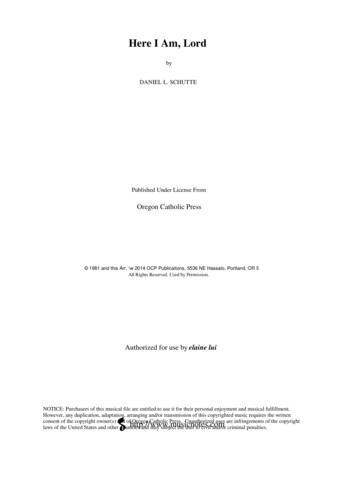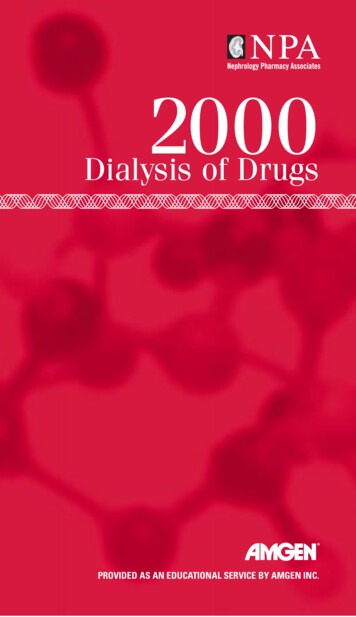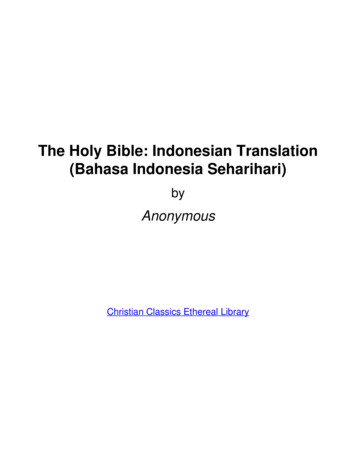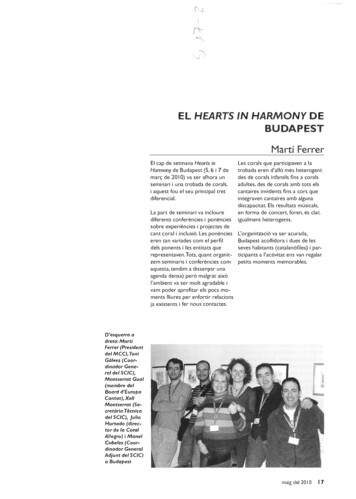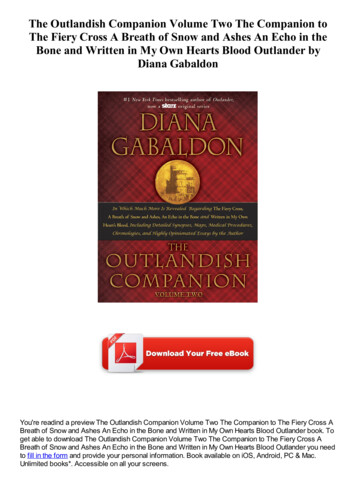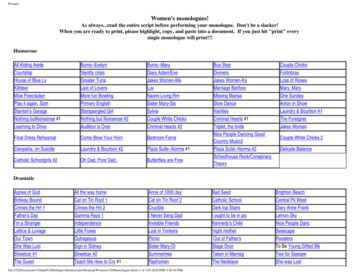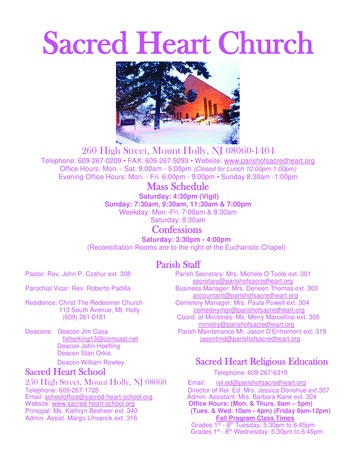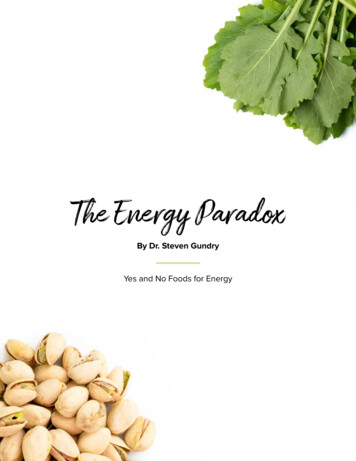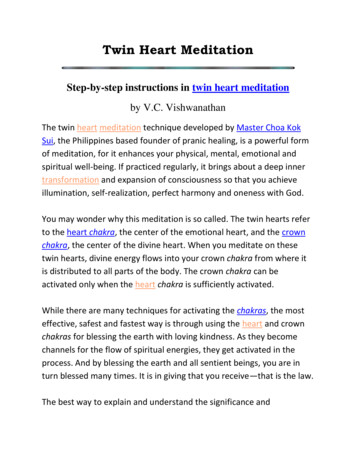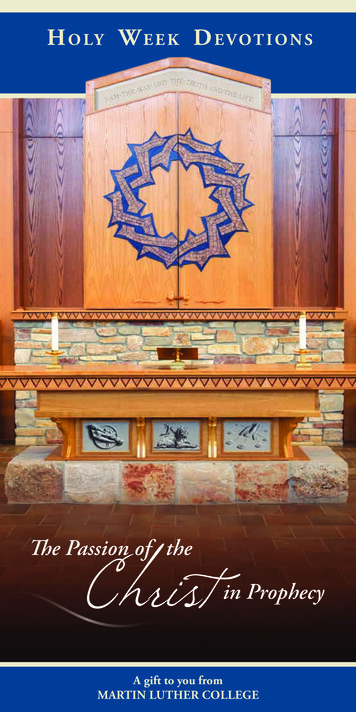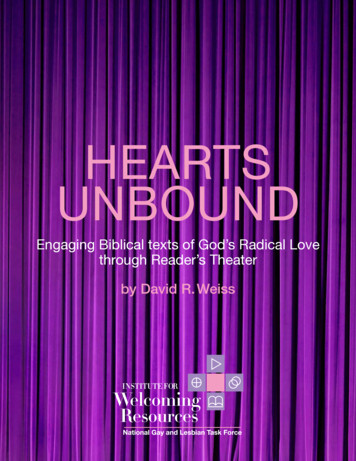
Transcription
THE BOOK OF RUTH1HEARTSUNBOUNDEngaging Biblical texts of God’s Radical Lovethrough Reader’s Theaterby David R. Weiss
THE BOOK OF RUTH1HEARTSUNBOUNDEngaging Biblical Texts of God’s Radical Lovethrough Reader’s Theaterby David R. Weiss1HIDDEN IN THE KING’S BLOOD:A Faithful Outsider Brought InTHE BOOK OF RUTH
2013 National Gay and Lesbian Task ForcePermission is given to download and photocopy this script for use by church or community groups.
Hearts Unboundby David R. WeissThis resource was created for the National Gay and Lesbian Task Force’s Institute for Welcoming Resources inpartnership with the ecumenical Welcoming Church Programs:Affirm United/S’affirmer EnsembleAssociation of Welcoming and Affirming BaptistsBrethren Mennonite Council for LGBT InterestsGLAD AllianceIntegrity USAReconcilingWorks: Lutherans for Full InclusionMore Light PresbyteriansUnited Church of Christ Coalition for LGBT ConcernsReconciling Ministries NetworkRoom for AllWelcoming Community NetworkDavid R. Weiss is the author of To the Tune of a Welcoming God: Lyrical reflections on sexuality, spirituality andthe wideness of God’s welcome (Minneapolis: Langdon Street Press, 2008). A theologian, writer, poet and hymnistcommitted to doing “public theology” around issues of sexuality, justice, diversity, and peace, David lives in St.Paul, Minnesota and is a self-employed speaker and writer on the intersection of sexuality & spirituality. You canreach him at drw59@comcast.net and at www.tothetune.com.All biblical passages are from The Inclusive Bible: The First Egalitarian Translation by Priests for Equality, a Sheed& Ward book published by Rowman & Littlefield Publishers, Inc. 2007 and appear here by permission of thepublisher. This biblical material is protected by copyright. All rights reserved. Except as included within thesescripts, please contact the publisher (The Rowman & Littlefield Publishing Group, 4501 Forbes Boulevard, Suite200, Lanham, Maryland 20706 USA) for permission to copy, distribute or reprint.
Dedicated toMichael J. Adee, M.Div., Ph.D.in honor and celebration of his 13 years asExecutive Director and National Field Organizerfor More Light Presbyterians, for helping break down barriersto full inclusion within the Presbyterian Church (U.S.A.),and for his role in helping found and shepherd theever-growing Multi-Faith Welcoming Movement.
THE BOOK OF RUTH5Introduction to Reader’s Theateras a form of biblical engagementReader’s Theater is the experience of reading a play script out loud using only the spoken lines — nothing else.The beauty of its simplicity is that it doesn’t require memorized lines, costumes, sets, or polished acting, but itnevertheless invites participants to step inside the text — to inhabit it through their roles — and to experience thetext more fully because they are involved in it themselves. Most of us were introduced to reader’s theater duringour first experience of dramatic works in middle school. These scripts invite you to revisit those middle schooldays as you use Reader’s Theater to capture the drama and surprise of these biblical texts.Because these scripts are only intended for use as Reader’s Theater experiences, there are no extra instructionsabout costuming, stage movement, etc. — only the dialogue assigned to each reader.Most biblical passages require a measure of context and scholarly insight in order for us to really understandthem. In these scripts the dialogue is crafted to allow biblical characters themselves — as voiced by you, theparticipants — to unpack and explore key biblical texts about welcome. Also, because the biblical story (themessage of God’s abounding love that runs from Genesis through Revelation) is ultimately an experience ofgood news, these Reader’s Theater experiences are best done in groups of 6-8 persons — so that, just as in ourfaith, there are no spectators.Whether used by persons skeptical, curious about, or eager to explore the biblical theme of God’s surprisingwelcome to outsiders, these Reader’s Theater experiences are effective because they do three things:1. hey engage minds imaginatively, using the power of the participatory-narrative experience to open upTand fully involve participants’ intellects.2. hey help participants evocatively make the connections between the biblical dynamic of a welcomingTGod and the challenge to be welcoming today.3. hey enable participants, through scripted comments, to begin rehearsing what they might say in theirTown voices to explain and apply the dynamic of welcome in their own contexts today.Lastly, one of the challenges of bringing biblical texts to life today is negotiating the “cultural sensitivities” thathave transpired across the years. This plays out in several ways.For instance, most of the biblical material was originally written by — and for — Jewish persons. (Though eventhe word “Jewish” isn’t quite accurate; historically, we’d need to say “Hebrew-Israelite-Jewish persons” as eachof these words best names these people at different points in their history.) So when these texts challenge thesepeople to recognize God’s surprising welcome, it’s an example of self-criticism. But when Christians read thesetexts — especially after generations of both implicit and explicit anti-Semitic assumptions — it’s very easy tohear them suggesting that the Jewish faith or tradition is intrinsically stubborn or narrow-minded, while we (ofcourse) are not. But the truth is that stubbornness and narrow-mindedness are human tendencies not Jewishones. In fact, it is our own stubborn, narrow-minded tendencies that tempt us to read these texts as challengingpeople other than ourselves. Please remember that insofar as we claim these texts as authoritative for us, they
THE BOOK OF RUTH6are seeking to challenge us. In every text, whenever someone is challenged to recognize that God is “bigger”than they assumed, that person, no matter what their ethnic or religious background is in the text, stands for us.We need to hear what they need to hear. Be sure to listen.Also, we know that gender roles were very different in the biblical era than they are today. This is not becauseGod so ordained them, but because culture and society develop and change over time. This means, however,that some biblical texts are very male-centered and some texts display gender assumptions that we would nolonger make today. I have tried to treat these instances with a balance of respect for the history they representand sensitivity to the way we regard gender equality today.And, you will discover, in my attempt to have these texts speak to us today, I occasionally allow the biblicalcharacters to speak directly to us across time. They sometimes make references to historical or contemporarypersons and events in order to help us see into the biblical text with greater insight. But even this is tricky,because my cultural and ecclesial (church tradition) knowledge and assumptions may differ markedly from yours.I try to offer references that are culturally diverse, but, if my attempts fall short or miss the mark, I hope that youwill do your best to hear past my shortcomings and listen for the truth of these welcoming texts as they seek tospeak to us still today.Indeed, each of these texts invites us, as we take our place inside them as participants in God’s great drama ofwelcome, to find our hearts unbound. Yes, God’s radical love can be described, but every description dims nextto the experience. One definition of the literary form of “gospel” explains it as a genre that aims to bequeath toits hearers the very experience it narrates. It doesn’t simply tell “good news”—it bears good news to each personwho encounters the story. In their own humble way, each of these Reader’s Theater scripts seeks to be gospel:not simply to recreate tales in which hearts are unbound, but to unbind the hearts that do the reading. I offerthem to a church that yearns to know God’s radical love more deeply in its own life. In these tales, retold in ourown voices, may we discover our own hearts unbound. David WeissEaster 2013
THE BOOK OF RUTH7IntroductionThis script invites you to explore the story of Ruth from the inside, through seven roles created to bring insightto this key biblical tale. These roles are: (1) Naomi, (2) Ruth, (3) Boaz, (4) Townspeople — assorted voicesin the background, (5) 3rd Isaiah — a prophetic voice contemporary to the book of Ruth, (6) Author — theunknown author of Ruth, and (7) Narrator. If necessary, to accommodate groups of six or eight, Third Isaiah andTownspeople can be read by one person, or the Narrator role can be shared by two persons.The two largest roles are the Narrator and the Author, followed by the roles for Ruth, Naomi, Boaz, and 3rd Isaiah.The Townspeople is the smallest role of all. None of the roles are overwhelming; no one speaks more than 10sentences at a time and most are only 4-5 sentences long. But you may appreciate having the option of choosinga larger or smaller part overall.The Narrator will guide you through the story of Ruth, summarizing the plot line and helping transition fromone scene to the next. The Narrator likely hasn’t seen any of this material before either, so this person isn’t the“expert” — their role is simply to keep things moving along. You’ll have a chance to add your own comments andquestions at the end, so feel free to make marks in your booklets along the way, but follow the script until you’reinvited to make your own remarks at the end.Remember, this isn’t a play where the goal is “perfect performance;” rather, it’s a series of invitations to slip intothe text ourselves and listen for a moment to discover what more we can hear within and between the lines of thestory of Ruth.Note: The Book of Ruth presents some complexity in how the events described in the tale, the overall messageof the story, and the historical context of its writing, relate to each other. It’s too important a tale to set aside justbecause of this complexity — but impossible to understand without addressing these things. The charactersexplain this in the Theater itself, but there is also a chart at the end of the script that allows participants to see thiscomplexity laid out on a timeline. The chart might be distributed and referred to as necessary.Suggestion: It may help keep the roles/voices clear for everyone if the Narrator sits at one end of the group, with Ruthand Naomi to one side and Boaz and the Townspeople to the other side. 3rd Isaiah and the Author might sit opposite theNarrator. You might also consider making large name places to put in front of people to identify their role.3RD ISAIAHAUTHORRUTHBOAZNAOMITOWNSPEOPLENARRATORNote: While the book of Ruth is only four chapters long, it’s too long to incorporate in its entirety intothis Reader’s Theater, so the characters summarize the action and lift up the key points. Everyonewill be able to follow things, even if they haven’t read the whole book, but it would be helpful toencourage participants to read the entire book of Ruth beforehand. (By generous permission of thepublisher, the Book of Ruth appears in its entirety as an appendix to this Reader’s Theater.)
THE BOOK OF RUTH8READER’S THEATER SCRIPTNARRATOR:Our task is to revisit each of the scenes in the Book of Ruth andreflect on them from the perspective of the original participants.Let’s begin by going around the table to introduce ourselves by ourreal names and then also by the roles we’ll be reading.NAOMI:My name is , and I’ll be reading the part of Naomi, aHebrew (Jewish) woman, now widowed and the mother-in-law of Ruth.RUTH:My name is , and I’ll be reading the part of Ruth, aMoabite (that is, a Gentile, a non-Jewish) woman, now widowed and thedaughter-in-law of Naomi.3rd ISAIAH:My name is , and I’ll be reading the part of ThirdIsaiah, the author of the final chapters (56-66) of the Book ofIsaiah. Although not a participant in the scene here, his words belongin this conversation, so his voice has been introduced into thisReader’s Theater.AUTHOR:My name is , and I’ll be reading the part of theAuthor, the unknown writer who created the Book of Ruth. In this roleI will offer “behind the scenes” comments to help you understand thestory from the author’s perspective.BOAZ:My name is , and I’ll be reading the part of Boaz, anupright Hebrew (Jewish) man and a close relative of Naomi’s deceasedhusband.TOWNSPEOPLE-FIELDWORKERS:My name is , and I’ll be reading the part of theHebrew (Jewish) Townspeople-Fieldworkers of Bethlehem, the city towhich Naomi returns with Ruth.
THE BOOK OF RUTH9NARRATOR:My name is , and I’ll be reading the part of theNarrator. In this role I will summarize the plot from the Book ofRuth. I’ll also help us transition from scene to scene, and I’lloccasionally offer some extra insight into the text.NARRATOR:Okay, we’ll begin with a few background comments on the Book of Ruth.Then we’ll turn to the story itself.AUTHOR:I would introduce myself, but since I’m “unknown” that’s a littledifficult. You see, like most of the books of the Bible, the Book ofRuth does not identify its author. There’s not even a tradition orlegend about who I might be. So I’m about as “unknown” as they come.Even the date for my writing is unknown. Some scholars believe I wrotewithin a couple generations of the story I tell — maybe around thetime of King David (1000 BCE). But most of them place me hundreds ofyears later. That’s because my message fits most clearly in the timeafter the Exile, 500-600 years after King David (500-400 BCE). Duringthese years the people of Israel wrestled with the place of foreignersin the community of God’s people.NARRATOR:Let me explain how we’re dating things. “BCE” means “Before the CommonEra;” it’s the same timeline as “BC,” which means “Before Christ,” butthe designation BCE is used by scholars today to recognize that noteveryone regards Jesus as Christ. Still, Jesus’ birth is what marksthe beginning of the “Common Era,” so when you hear BCE it simplymeans the number of years before the Common Era began, which is alsothe number of years before the birth of Jesus.3rd ISAIAH:Okay, to make matters even more complicated, I’m also an “unknown”author. I’m the voice behind the final chapters of the Book of Isaiah.Virtually all scholars acknowledge that most of the first 39 chaptersof Isaiah have roots in the actual prophet Isaiah, who was active from740-687 BCE. That’s right before and right after Israel’s Northern
THE BOOK OF RUTH10Kingdom fell to the Assyrian Empire. But the material in chapters 4055 comes from a different voice and reflects a different time. Thismaterial is often referred to as “Second Isaiah.” It comes from anun-named prophet active around the time that the Babylonian Exilewas ending, some 150 years later than the original Isaiah. And manyscholars hear yet another voice in chapters 56-66, a third prophet whosees himself continuing the legacy of Isaiah, but who is now speakingto Israel’s reality after they’ve returned from the Exile, perhapsjust a generation or two after Second Isaiah. That third voice is me.[Participants might pause and locate Third Isaiah on the Timeline –page 24 — and keep the Chart close by as the next four speakers fillout the history and context for the story.]AUTHOR:I know this can all seem kind of complicated and a bit hard to follow.After all, this isn’t your history, it’s ours. But bear with us,because the history sets the context for understanding my story aboutRuth. While this tale describes events that happened 500 years beforethe Exile, when heard against the backdrop of Israel’s life after theExile, it reveals an astonishing message about God.3rd ISAIAH:So before we turn to the tale, keep this in mind. In 722 BCE theNorthern Kingdom, comprising almost all of Israel, was conquered bythe Assyrian Empire and scattered to the four winds. After 722 BCEthese ten tribes were effectively lost to history; they’re sometimesreferred to as “the lost tribes of Israel.” About 130 years later,between 597 and 587 BCE, another regional superpower, Babylon,conquered Assyria and swallowed up the last remnant of Israel, thenknown as the Kingdom of Judah. These last Israelites — members of thetribes of Judah and Benjamin — were deported to Babylon, where theylived in exile for about fifty years.AUTHOR:Around 539 BCE, a third regional superpower arose, the Persian Empireled by Cyrus, and they conquered the Babylonians. Cyrus decided tolet the Israelites, who had been living in exile in Babylon, returnto their homeland. Many of them did. And over the next hundred years
THE BOOK OF RUTH11one of the driving theological questions for the people of Israelbecame, “What went wrong. why did the Exile happen?” One of thereasons most often given was that Israel had been “too friendly” withher neighbors, and the resulting intermarriages had led to their beingattracted to foreign gods.3rd ISAIAH:One response was an emphasis on ethnic purity. The books of Ezraand Nehemiah convey this response. First a priest (Ezra) and then agovernor (Nehemiah) declared that God was opposed to all intermarriage.But this wasn’t the only view. There were other biblical voices —like mine, and the authors of both Ruth and Jonah — who understoodGod in ways that ran counter to Ezra and Nehemiah. So the story ofRuth offered itself to the imagination of Israel in the midst of thisdebate about how to treat foreigners — and about how God regardsforeigners. Most scholars consider the story of Ruth to be historicalfiction or purposeful folklore. But that doesn’t mean it was any less“inspired” than other imaginative tales like, say, Jesus’ parables.Just like the parables, the truth of Ruth doesn’t rest on the historyit tells but on the theology it offers.AUTHOR:Enough already! If I’ve done my work well, the story will stand onits own. You know the context now, so let’s turn to the tale itself.I begin by putting the two main characters in place — or, moreaccurately, by putting them clearly out-of-place. Naomi is a Hebrewwidow. Ruth is her daughter-in-law. Years earlier, during a famine,Naomi journeyed with her husband from the land of Israel to the landof Moab, only to have him die there, leaving her alone with two boys.The boys grew up and both of them married Moabite women. But soon bothof Naomi’s sons die as well, and she is left only with two foreigndaughters-in-law, in a foreign land. Now, to be a widow in your ownland in the ancient world was bad enough; to be a widow in a foreignland, tied only to other widowed women — and foreign women, at that —Naomi was truly to be out of place.NARRATOR:The rest of chapter one can be summed up like this: Naomi learns thatthere was food again in Israel, so she decides to return to her people.
THE BOOK OF RUTH12Although her two daughters-in-law initially set out with her, Naomidoes not wish them to now be out of place in her land. So she urgesthem to stay in Moab and expresses her hope that each of them may findsecurity by finding a new husband among their own people. After a bitof protesting, one of her daughters-in-law agrees to stay in Moab, butthe other one, Ruth, is almost defiant in her loyalty to Naomi. Andultimately Naomi allows Ruth to return with her to Bethlehem.AUTHOR:Wait! You can’t sum it up and leave out the best parts. Think aboutthis: in an almost exclusively patriarchal society I dared to write ashort story featuring women. I dared to think that their feelingsand their words might be memorable. In fact, at least a few scholarswonder whether I might have been a woman storyteller myself to craftsuch lines for women. This is what Ruth said when Naomi encouraged herto go back to Moab:RUTH:“Please don’t ask me to leave you and turn away from your company. Iswear to you: Where you go, I will go; where you lodge, I will lodge.Your people will be my people, and your God, my God. Where you die,I’ll die there too and I will be buried there beside you. I swear —may YHWH be my witness and judge — that not even death will keep usapart.” (Ruth 1:16-17, “The Inclusive Bible - TIB”)AUTHOR:No wonder Naomi relented and welcomed Ruth’s company. These words havebeen echoed as expressions of fierce friendship — even borrowed foruse in weddings — for thousands of years since I penned them!3rd ISAIAH:But remember this, too, that Ruth, who makes this stunning pledgeof loyalty, is a Moabite. Her people are cursed in the Book ofDeuteronomy, where it says that no Moabite shall be allowed to jointhe “assembly of the Lord” not even after ten generations — which isa fancy way of saying “not ever!” And after the Exile both Ezra andNehemiah insist on breaking up all intermarriages between Hebrew menand Moabite women. Ruth carries some pretty significant ethnic baggagewith her, but here her loyalty to a Hebrew widow is given an eloquence
THE BOOK OF RUTH13that makes it a fitting metaphor evenfor God’s loyalty to us.NAOMI:I was blessed by Ruth’s companionship.I knew that she would be an outsideramong my people, but, as a widow myself,I would also be an outsider even in myown land. Who can explain the depthof Ruth’s loyalty to me? But who canquestion such loyalty either? Hers wasa gift of grace to me. In a world wherewidowed women had nothing, we chose tohave each other.NARRATOR:So the two women arrive in Bethlehem,where the relatives of Naomi’s deadhusband lived. The townspeople are“abuzz with gossip” at their arrival.Naomi has been gone for more than adecade — and she had left with a husbandand two sons. Now here she is: a widowwithout children, in the company ofa foreign woman. Her fortunes havechanged, to say the least. They arrivein town just as the barley harvestis being gathered. And Ruth, showingcompassion for her mother-in-law, offersto go into the fields to glean barleyfor them to eat. By chance — or byProvidence — she gleans in the fields ofBoaz, a kinsman of Naomi’s husband.No Ammonite or Moabite, even downto the tenth generation, may enterthe assembly of YHWH, for they didnot come to meet you with food andwater on your journey out of Egypt.You are not to seek their welfarenor their goodwill as long as youlive. (Deuteronomy 23:3-4, 6 TIB)Shecaniah ben-Jehiel, of the familyof Elam, told Ezra, “We have beenunfaithful to God by marrying theforeign people of the land. But there isyet hope for Israel. Let us now makea covenant with YHWH to disownour foreign spouses and children.”And they dismissed them and theirchildren. (Ezra 10:2-3, 44 TIB)It was in those days that I [Nehemiah]saw Judeans marrying Gentiles fromAshdod, Ammon, and Moab. Halfof their children spoke the languageof Ashdod or some other tongue,and not the language of Judah. Iscolded them and cursed them; Ibeat some of them and pulled outtheir hair, and made them take anoath in God’s name, saying to them,“You shall not give your children inmarriage to their children. Nor willyou take their children in marriagefor your children, nor for yourselves.”(Nehemiah 13:23-25 TIB)AUTHOR:Hold on! Does everyone know what “gleaning” means? See, the people ofIsrael recognized that God wanted mercy shown to the poor, to those atthe margins of society. Thus, Israelite law required those harvestingthe fields to leave a portion of the harvest in the field, so that
THE BOOK OF RUTH14the poor could follow behind and “glean” — that is, “gather” — thisleftover grain for themselves. In this scene, Ruth sets aside any ofher own remaining dignity to enter the field and gather barley inorder for her and Naomi to survive.NAOMI:Why didn’t I go myself? Why didn’t I accompany Ruth into the fields?The story doesn’t say, perhaps I was simply too old. Or perhaps thesorrows of my years had left me too frail to be much help. In anycase, Ruth’s gleaning — this care shown to me by a foreigner, mydaughter-in-law — is what kept both of us alive.NARRATOR:When Boaz comes to the field where his workers are reaping the harvest,he notices Ruth, whom he doesn’t recognize, following behind hisworkers and he inquires about her. The servant in charge tells him sheis “the Moabite” who came back with Naomi, and he adds that Ruth hasgleaned in the field tirelessly all day. In response, Boaz tells herthat she is welcome to glean in his fields — indeed he urges her toglean only in his fields and invites her to share the water providedfor his own workers. At the midday break he invites her to sit withthe reapers and share their meal. And afterwards, he instructs hisservants to allow Ruth to glean even where they have not yet harvestedand to toss some extra barley on the ground for her to collect.RUTH:I was quite overwhelmed by his generosity, and I told him so — whilebowing low to the ground in front of him. That’s how we showed deeprespect and honor to those whose place in life was far above our own.It wasn’t just that he took his duty to the poor so seriously, butthat he offered it so willingly to me, a foreigner. I had expected tobe invisible, but he saw me.BOAZ:Word travels quickly in a small town. Although I didn’t recognize herin the field, I had already heard about this foreign woman, Ruth, andher faithful companionship to Naomi, the widow of my kinsman. So Iwas sincere when I said to her, “May YHWH pay you in full for yourloyalty! May you be richly rewarded by the Most High God of Israel,
THE BOOK OF RUTH15under whose wings you have come to find shelter!” (Ruth 2:11-12 TIB)In fact, as soon as I spoke my blessing, I was strangely aware it wasshe who had spread her wings of refuge over Naomi and that it wasI, through the barley in my fields, who was now spreading my wings ofrefuge around them both.TOWNSPEOPLE-FIELDWORKERS:They say beauty is in the eye of the beholder. And when the eyebelongs to a beholder who is just, mercy looks beautiful. We could seethat something sparked in Boaz already during that chance encounter inthe field, but it belittles it to call it “love at first sight.” Ruthwas a young woman to be sure, but she was widowed already and, afterworking the whole morning in the field, she was hardly in a state tocatch anyone’s eye. But we knew Boaz to be a man moved by justice, andwhen he looked at Ruth he saw neither her physical beauty nor the tollof her years. He saw the mercy she showed Naomi and that moved himdeeply.RUTH:At the end of the day, after separating the grain from the straw, Ihad an ephah of barley — about enough to fill a five-gallon bucket.It was a very good day of gleaning. And when Naomi saw how much I hadgleaned she immediately asked whose field I had been gleaning in,because she knew someone had been looking out for me.NAOMI:When Ruth told me that she had been in the field belonging to Boazmy heart leapt, because he was a relative of my dead husband. Thiswas God’s kindness for sure. Most English Bibles say “close relative”or “nearest kin,” but this doesn’t capture the full significance ofmy words. More accurately, in Hebrew I told Ruth, “This Boaz is ourredeemer-trustee” (Ruth 2:20 TIB); literally, he is the one with theright to redeem.BOAZ:”One with the right to redeem.” That’s a big deal.might well have two significant opportunities — orrespect to Naomi. First, unless an even closer kinwould have the right to “redeem” — to claim for myIt means that Iobligations — withcame forward, Iuse — any lands
THE BOOK OF RUTH16that were held by Naomi’s husband. Second, I also had the obligationto provide Naomi with an heir, through the custom of “leviratemarriage.” That meant that (whether or not I already had a wife —though I seem to have been unmarried) I had a duty to marry Naomi sothat she might conceive an heir to care for her in her old age and toinherit her husband’s land.NARRATOR:So Ruth gleaned in the fields of Boaz for the duration of the barleyharvest, and for the wheat harvest as well. This lasted about threemonths, during which time Ruth became a familiar fixture followingbehind Boaz’s fieldworkers, likely encountering Boaz on numerousoccasions.NAOMI:This was surely God’s doing, for the LORD is merciful to the poorand needy. And Ruth’s ability to glean all these months ensured thatwe would have food for a long time. But there is more than food tosecurity. And in this era the only real security for a woman was ahusband, or at least a son to take care of her when she grew old.Because both Ruth and I had neither husband nor children, I began toplan for our security.NARRATOR:Naomi instructed Ruth in how to “seduce” Boaz. She picked a nightthat she knew Boaz would be alone in the grain house. She told Ruthto bathe and put on some perfume and to dress in her finest clothes.But Naomi also instructed her to hide until Boaz had eaten and fallenasleep. Then she was to go, lie down by Boaz, “uncover his feet,” andwait for him to tell her what to do.AUTHOR:“Seduce” is a little strong, I think. There are clear sexual overtoneshere, but this is really a desperate attempt by Naomi through Ruth togain security for both of them. Knowing that she herself was too old tobear a child, Naomi hoped that Boaz might be “encouraged” to “redeem”her family by taking Ruth as his wife and providing Naomi with an heirthat way. Ruth’s actions are pretty forward — in Hebrew “feet” can bea euphemism for genitals, so just what is Naomi suggesting that Ruth
THE BOOK OF RUTH17uncover?! But they’re also unmistakably vulnerable: regardless of whatpart of Boaz’s physical anatomy she’s uncovering, Ruth is also layingbare her future security, and that of Naomi as well. Boaz’s responseis far from certain, and she has everything to lose if this moment ofsheer vulnerability on her part is not met with grace and mercy on hispart.RUTH:I did just as my mother-in-law suggested. Once Boaz was asleep I creptin and lay beside him, uncovering his feet. No wonder when he awokein the middle of the night he was startled to find me there! When heasked who I was — for he couldn’t see me clearly in the darkness, I
THE BOOK OF RTH 1 HEARTS UNBOUND Engaging Biblical Texts of God’s Radical Love through Reader’s Theater by David R. Weiss 1 HIDDEN IN THE KING’S BLOOD: A Faith
